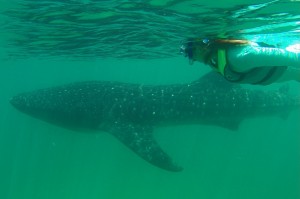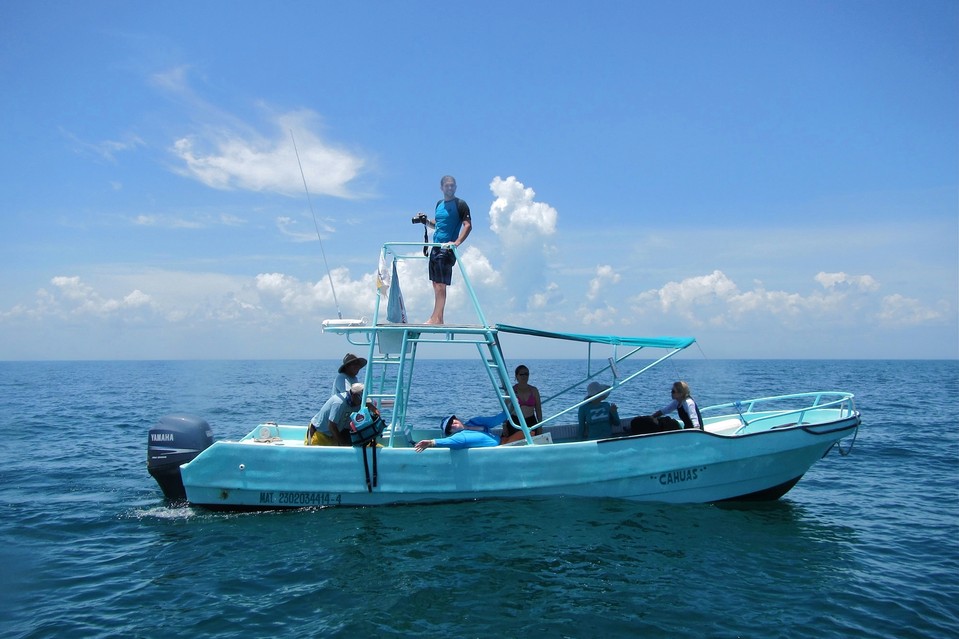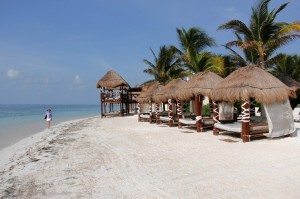In the waters off the Yucatán Peninsula, travelers can get up close to the largest sharks in the world.

It seemed like we’d been searching for the sharks for hours. Our group had actually only been motoring through the Gulf of Mexico for 40 minutes, scanning the Mylar-smooth water for telltale fins. But anticipation had made time sluggish.
For most of us, this trip off Isla Holbox, an apostrophe at the tip of Mexico’s Yucatán Peninsula, was the culmination of a longtime dream. Once we saw them—if we saw them—we’d get the chance to swim alongside the largest fish in all the world’s oceans, what our Spanish-speaking guides called tiburones ballenas, or whale sharks.
In theory, they should have been easy to spot. Measuring up to 40 feet in length and weighing as much as 11 tons, the sharks—which are harmless to humans—have spotted skins that prompted locals to nickname them “dominoes.” The creatures typically feed at the surface on calm sunny days, suctioning great volumes of phytoplankton into their mouths. So, where were they? We all scanned the unruffled sea.
Suddenly, our boat captain shouted above the noise of the outboard engine: “A la izquierda!” As he spun the steering wheel to the left, we saw them: twin rudders cleaving the ocean surface, one about a dozen feet behind the other. The rounded dorsal fin was splotched with white; following it was a notched dagger point, the caudal fin—the tip of the shark’s tail.
“Get ready!” a guide called, as we slowly pulled abreast of the shark. The passengers who were to jump in first, a couple named J.R. and Karen, were already pulling on fins and snorkels. The rest of us leaned over the gunwale to marvel at the shark: its dappled, roughly 30-foot length; its broad, flat head; the lazy, sinuous switches of its great tail.
“Jump!” the guide instructed, pulling on his mask and sliding over the side. J.R. and Karen followed; we watched, half entranced and half envious. Our turns would come.
I first learned about whale sharks almost 20 years ago, from friends who’d encountered them on the other side of the world. Back then, Ningaloo Reef, off the northwestern coast of Australia, was believed to be one of the only places to see the sharks, about which very little was known. They were thought to travel vast distances—thousands of miles—but marine biologists had no specifics about their migratory patterns. Mating and reproductive habits were also obscure.
Scientists still don’t have much data on whale-shark behavior. Fishermen and divers who spot the animals routinely supply much of what’s known: whale sharks are solitary swimmers, have skin patterns as individual as fingerprints and consume masses of plankton, krill and tiny fish. This single-minded pursuit of food appears to make the sharks nearly oblivious (and benign) to humans.
 In the past decade, the waters off Isla Holbox—a 27-mile long curl of sand and mangrove thickets, where the Gulf of Mexico converges with the Caribbean Sea—have been identified as hosting the world’s highest concentration of whale sharks. According to Mexico’s National Commission of Natural Protected Areas, as many as 600 come to feed here between May and October—and particularly during the month of July, when currents sweep stores of plankton from more southerly ocean depths into the shallow waters around the Yucatán.
In the past decade, the waters off Isla Holbox—a 27-mile long curl of sand and mangrove thickets, where the Gulf of Mexico converges with the Caribbean Sea—have been identified as hosting the world’s highest concentration of whale sharks. According to Mexico’s National Commission of Natural Protected Areas, as many as 600 come to feed here between May and October—and particularly during the month of July, when currents sweep stores of plankton from more southerly ocean depths into the shallow waters around the Yucatán.
In 2009, Mexico’s government established a protected marine area for the sharks, encompassing roughly 510 square miles north of Isla Holbox. Though other feeding areas have since been discovered in the region, in this one, tour operators and guides must adhere to strict regulations for approaching the creatures. Around 60 different tour operators now troll the preserve from Holbox, offering outings to an increasing number of tourists.
For my own trip, I chose Natural Habitat Adventures, a U.S.-based outfit I’d traveled with previously. I liked the fact that the company’s trips focus on wildlife conservation (it has a partnership with the World Wildlife Fund, and a portion of trip fees go to WWF programs). I also appreciated that it works with local guides, keeps groups small and attracts outdoorsy, adventurous travelers.
The seven of us who converged for a five-day trip this July, in the mainland town of Puerto Morelos, were a fairly amphibious bunch. Along with our guides, Astrid Frisch and Karel Beets —married naturalists who have been leading tours in their native Mexico for decades—were Libby, who’d tried cage-diving with great whites off South Africa, and Julia, who’d snorkeled among sea lions in the Galápagos. But there was also Molly Kate, who had a lifelong fear of deep water.
On our first day, we discovered that Holbox is a near-picture-perfect island village. Hand-painted pangas (open fishing boats) are docked at the shore; there’s a tiny square where kids play on a fenced soccer pitch. Seafood restaurants and cheerful shops line the sandy main street. There are no cars—just golf carts, including a fleet of bright-yellow “taxis” that transported us to a beachfront hotel on the other side of town.
 Over the next few days, we explored some of the island’s natural landscapes—including Cabo Catoche, a cape whose dense mangroves and shallow estuarine waters function as a nursery for fish and crustaceans, and Punta Mosquito, where hundreds of flamingos and frigate birds make their home. We spotted some of the area’s other impressive marine creatures—including sea turtles, bottlenose dolphins and giant manta rays.
Over the next few days, we explored some of the island’s natural landscapes—including Cabo Catoche, a cape whose dense mangroves and shallow estuarine waters function as a nursery for fish and crustaceans, and Punta Mosquito, where hundreds of flamingos and frigate birds make their home. We spotted some of the area’s other impressive marine creatures—including sea turtles, bottlenose dolphins and giant manta rays.
But the night before our first whale-shark excursion, the excitement at our dinner table was palpable. It was abundantly clear what we had all really come for.
“You’ll go in the water two at a time, with a guide,” Mr. Beets told us during our pre-meal prep talk. We were to stay at least 6 feet away from the animals, he said.
“What about the mouth?” someone called out, to my relief. The photos I’d seen of the sharks’ wide, slotlike maws—which they use along with their gills to vacuum up and filter nutrient-filled seawater—had made me slightly nervous.
“You won’t get sucked in,” Mr. Beets reassured us. “But when you swim with them, stay to one side. If you get in front, sometimes they spook and dive.”
The next morning, 20 miles from shore in our panga, I was trying not to freak out as I pulled on my fins. When my turn came to jump in with the shark, I was hyperventilating before I even hit the water.
As soon as I was in, I found myself kicking with all my might. From the boat, the shark had appeared to be floating listlessly, but in the water it took every ounce of my strength to keep up. At first, it was almost too big to see properly; peering through my mask, I could only discern the shark’s vast, spotted flank, gills fanned out like spinnakers. I was able to stay alongside for only a minute or so before my legs and lungs maxed out, and I had to climb back aboard.
That afternoon, though, I got many more chances for close encounters; we saw almost a dozen sharks that day, as well as a 12-foot manta ray. By my fourth time in the water, I’d begun taking in beautiful details of the sharks’ appearance: the way their tiny eyes were placed, almost like afterthoughts, next to the corners of their gaping mouths; the colonies of remoras, or suckerfish, that fluttered like pennants along their pectoral fins; the swirling dotted patterns on their skins, which reminded me of aboriginal Australian paintings.
On my last swim, when I was too tired to kick anymore, I watched as a shark curved slowly past me and disappeared from view. I surfaced just in time to see Molly Kate—my water-phobic co-traveler—leap off the panga, flanked by guides. I pulled off my snorkel and whooped—for her, and for me, and for the great, hulking mystery we had shared.
The Lowdown: Swimming With Whale Sharks off Mexico’s Yucatán Peninsula
Swimming With Whales: Natural Habitat Adventures runs six-day tours for groups of up to 15 in July (from $3,995 a person, including gear, food, lodging and guided tours, nathab.com). From June to September, Holbox-based outfitter Turistica Moguel offers day and multiday tours to swim with sharks (from about $95 a person, including lunch and equipment, holboxislandtours.com).
Getting There: More than a dozen U.S. carriers fly direct to Cancún, including JetBlue, Delta Air Lines, and US Airways. The resort town of Puerto Morelos, where Natural Habitat Adventures’ trips begin and end, is about a 20-minute drive from the airport.

Staying There: Trips with Natural Habitat Adventures include lodging at two hotels, which can also be booked independently. On Isla Holbox, Villas Paraiso del Mar has rustic yet comfortable thatch-roofed suites with air conditioning (from about $175 a night, hmhotels.net). In touristy Puerto Morelos, Azul Beach Hotel has posh beachfront suites and a lovely spa—but unfortunately is popular with wedding parties (from about $445 a night, karismahotels.com).
What to Pack: Guides normally provide masks, snorkels and fins, but you may want to bring your own for fit and comfort. Since the expeditions are on open boats, sun protection is critical: You’ll need a hat, a rashguard and biodegradable sunscreen. And don’t forget bug repellent; the mangroves that surround Isla Holbox are a prime breeding ground for mosquitoes.


